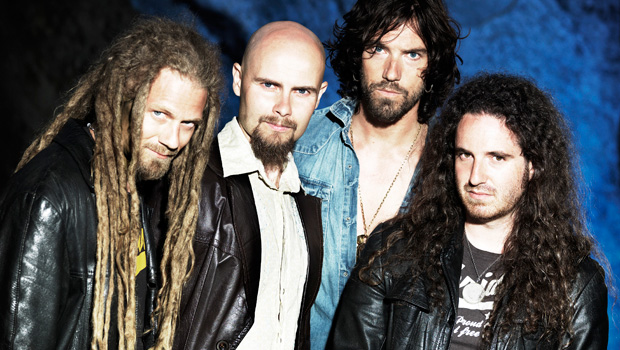
Sweden's Pain of Salvation are a "progressive" band in the best sense possible. Depending on where you came in on the band's catalog, you could have a vastly different first impression from someone who was either an album ahead or behind you.
Personally, my first taste of Pain of Salvation was 2007's Scarsick, which, through the first two songs, might lead you to think you had found Sweden's heavy metal equivalent of Faith No More. Of course, after exploring the rest of the band's back catalog, I was (pleasantly) surprised to find that no two albums really sounded alike.
At least until now, and that's certainly not a band thing. The band's latest release, Road Salt Two, is the follow-up to 2010's Road Salt One, and fittingly, there is a strong sonic link between the two albums. This time around, though, Pain of Salvation sound like they have way more in common with Tres Hombres than King for a Day... Fool for a Lifetime. To explain the band's ever-evolving sound, we caught up with Pain of Salvation mastermind Daniel Gildenlöw.
GUITAR WORLD: So this new album is a continuation of your last album, Road Salt One. How do you think the theme and the sound have evolved since you started work on the second part?
Well, the sound hasn't really evolved a lot. I think I'm closer to my vision of the sound on part two than I am on part one, basically because I've worked with it more. Conceptually it's more or less the same. It was all written and recorded at basically the same time, so I guess they're pretty similar in most ways. I think Road Salt Two might be experienced as a bit darker and heavier when you listen to it the first time, but honestly I don't know.
There are definitely some darker, bluesy elements on this album, especially on a track like "Softly She Cries." Where does that almost classic-sounding blues influence come from?
One thing I can completely pinpoint, I got this small vinyl player for my rehearsal room, and I sort of wanted a lot of '70s stuff in there, a nice natural vibe. Johan, the guitar player, actually came across three big crates of vinyls and asked me if I wanted them. There was one half-crate that was nothing but Jimi Hendrix albums, which was insane!
Get The Pick Newsletter
All the latest guitar news, interviews, lessons, reviews, deals and more, direct to your inbox!
So I would come into the rehearsing room and the first thing I would do is turn on the vinyl player and randomly pick out an LP and listen to it while I was hooking the computer up, and preparing whatever else I was going to do for the day.
I found this guitar album called Rio Grande Mud. Even though I was born in the '70s, a lot of my musical history took place in the '80s, so when I think ZZ Top I'm really thinking Afterburner -- that type of stuff. These funny beard guys with this extremely slick production, that was ZZ Top to me.
But when I picked up this album, I knew I had heard of this band but I flipped over to the back and said, "Wait a minute, they don't have beards! I have to listen to this!" And I really loved the sound and the whole vibe of that album, so I think that was definitely in there, along with all these other influences.
Dare I ask, have you heard any of the more recent versions of the album?
I ended up buying it from iTunes and it sounds crap. Apparently they remixed the album for CD. All the reverb and the grittiness is gone. I have a pretty stinking vinyl player too. Maybe that helps, I don't know. [laughs] But it's so gritty and so punchy. The guitar sounds are just wonderful.
Do you feel a strong connection with the music of that period?
I know I'm going to piss a lot of people off in saying this, so I apologize beforehand, but then I listen to like Led Zeppelin or the Doors, it gets so close to something that I would really like, but it never gets there all the way for me. And I like the vibe, I like the integrity, the sound and the whole charisma around the bands, but I just never feel like the songs connect with me on that magical sort of level.
Never?
Maybe once in a while. Led Zeppelin had a few songs that I really, really love, but there's just a lot of not-so-good stuff there. That's just my subjective taste coming into the picture.
So I wanted to make my own alternative to that. What I tried to do from a song point of view. In retrsopect, you know you have the '60s and the '70s and then the production style sort of drifted into the '80s and '90s. But if we sort of imagine for a while that it didn't, that it kept going in the way it was through the '60s and '70s, that the '80s would have been something different, something that come out of the '70s and kept going...
I like to think sometimes that we would end up with the sound on these records [Road Salt One & TWo] somewhere around 2011. [laughs]
What steps did you take in the production of Road Salt Two to ensure that it had some of the sonic qualities of those old records?
I basically went back to square one with every part of the process. I decided very early on that I would bring the recording to the rehearsing room. A lot of my favorite albums out there are recorded that way.
I was always frustrated with the whole demo thing, because when you make demos, you create. The demo is the first time you record the song, and things will happen in that recording. Then when you get to the studio, you're trying to recreate instead of creating, and there will always be a few moments that you cannot recreate. So I wanted to make the time from composing to recording as short as possible, as direct as possible.
I also wanted to be able to play the guitars, keyboards and drums simultaneously and record it. When you have people playing at once, you get a certain chemistry that you will not get if you record one instrument at a time.
Talk a little bit about your guitar selection for the album.
I used an Epiphone, I used a Gibson Les Paul. I used a lot of Mayones guitars, including the fretless ones. I used a dobro guitar. What's the name of it? Tanglewood, that's it! I also used three different mandolins, two different lutes... I did use a Fender Telecaster at some point. For amps, I used a Laboga stack and a Laboga combo, a Chinese Vox, and a really cheap Fender.
Having been a fan of the band for a while, I've seen you guys experiment with everything from progressive metal to disco, certainly taking some surprising turns for fans. Are there any areas you'd really like to explore in the future?
Usually I surprise myself to the same extent. [laughs] The fact that all the different Pain of Salvation albums have changed in sound and style is pretty much... I make the kind of album that I want to hear myself at that given point. Which means that right now, I want every album in the world to sound like Road Salt. [laughs] But I also know from experience that in two years' time, I will be elsewhere in my preferences and I have no idea where that is.
I guess you could take a hint in listening to the last recorded songs of any album, and for Road Salt, the last songs were "1979," "To the Shoreline" and "Through the Distance." They do have a different style, a little bit, than the rest of the Road Salt journey, and maybe that's a little clue as to where I'm heading.
The new album from Pain of Salvation, Road Salt Two, is out now on InsideOut Music.
Josh Hart is a former web producer and staff writer for Guitar World and Guitar Aficionado magazines (2010–2012). He has since pursued writing fiction under various pseudonyms while exploring the technical underpinnings of journalism, now serving as a senior software engineer for The Seattle Times.
“I heard the Money solo and thought, ‘This is amazing!’ So I sent David a telegram saying, ‘Remember me? I'm in a band now called Roxy Music’”: Phil Manzanera on his friendship with David Gilmour, and the key to the Pink Floyd man's unmistakable tone
“It’s really quite genius, but also hard to learn – it sounds insane, but sometimes the easiest songs still get me nervous”: Kiki Wong reveals the Smashing Pumpkins song she had the most trouble with











